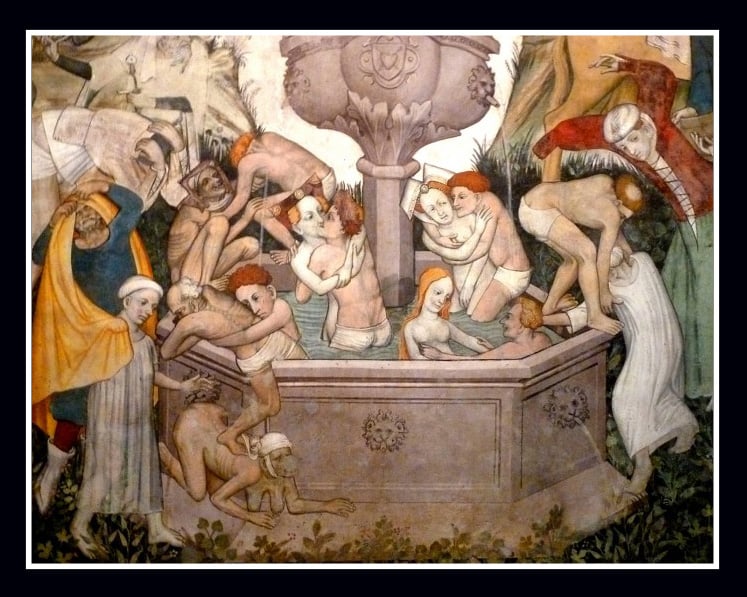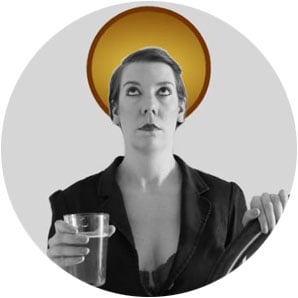When people think about the Middle Ages sex, medieval porn isn’t usually the first thing they think of. There’s a lot of good reasons for this but one of the biggest is that the medieval period—which runs from the ‘fall of Rome’ in 476 to the sixteenth century was a really long time ago. The sources that survive to us needed to last for hundreds of years and so the ones that do usually come from large institutions like the Church or royal courts.
The Church, famously, is and was not that into sex for any reasons other than procreation. According to St Augustine, who wrote extensively on sex and theology, the sin of Adam and Eve was eating the fruit of the tree of knowledge and then realising that they were naked and being turned on by that fact. The best Christians, according to him and the Church in general were the sort of people who could overcome their libidos and never think about sexuality. Royal courts are similarly bad places to go looking for erotic information. If you think about the sort of information that gets passed down through the ages it’s usually about taxes, wars, and property. No one tends to preserve their sex lives for posterity on a government level.
However, this doesn’t mean that people weren’t having a lot of sex, or that they weren’t writing, thinking, and drawing about it in ways that we wouldn’t expect. It is just that you tend to find sexual images or erotic writing in places that we wouldn’t necessarily think to look for it.
One of the best places to find erotic ideas is actually in religious texts and especially those that survive to us from women. In the high to late medieval period (which means 1100 or so onward), many women wrote of divine visions that they received from God, and a lot of them were surprisingly sexual. One such mystic was Mechtild of Magdeburg, a nun who lived and wrote in the thirteenth century. She saw herself as in a direct relationship with Jesus and wrote about visiting with him and about their inevitable marriage when they met in heaven. This was common, as nuns were encouraged to see themselves as being quite literally married to Christ. What was unusual was how sexual Mechtild felt about that idea. She wrote of herself and this relationship saying, that Jesus was almost erotically excited by her faith. According to her, “He lives in the peace of holy affection and whispers to his beloved in the narrow confines of the soul. He also embraces her in the noble comfort of his love. . . He kisses her passionately with his divine mouth. You are happy, more than happy, in this most glorious hour. He caresses her, as well as he can, on the bed of love. Then she rises to the heights of bliss and to the most exquisite pain when she becomes truly intimate with him. Ah, dear Soul, let yourself be loved and don’t fiercely fend it off.”
Some religious women went even further. The saint and mystic Hildegard of Bingen who wrote extensively on the nature of God and the universe, illustrated a vision that she had of the universe as what looks like a giant vulva, complete with stars where the clitoris would be. She described it modestly as an ‘egg’, but coming from the first woman who ever wrote about the experience of the female orgasm in Europe, it is pretty clear that she knew exactly what she was doing.
Illumination accompanying the third vision of Part I of Scivias
This is not the only place that we can find what look like genitals in religious art. It was common for wealthy Europeans to commission devotional books of prayers and images to guide their religious meditations. A very common art trope in these books was Christ’s side wound, gained when Jesus was run through by the lance of Longinus who put him out of his misery. It looked like a vulva. More than that, we know that part of that devotion involved stroking or even kissing these images, as analysis finding particles of spit on such images has shown.
Cloisters Collection
Elsewhere you can find sexual images in warning about how you definitely shouldn’t be thinking about sex. Images of luxurious brothels where men lounged with beautiful naked women in baths while feasting.
Berlin Staatsabibliotek
This was meant to be a warning of how easy it was to fall prey to the delights of the many legal medieval brothels and a reminder to turn yourself away from these luxuries. But these stern warnings acted as a sort of plausible deniability. Artists could get away with making the sexiest brothel seen they could imagine, provided they added a caption shaking their heads and saying how bad it was to like sex this much.
This is what we see on display in the famous Hieronymus Bosh painting the Garden of Earthly Delights. The left side shows Adam and Eve in the Garden of Eden—a reminder of what life could be like in heaven if you play your cards right. On the right side we see a vision of hell and the fiery torments that await sinners. The middle, which is the size of the other two panels combined, is the titular garden. It is an orgy where naked men and women cavort, eating berries and sticking flowers up each other’s bums while hanging out with fantastic, beautiful beasts like mermaids. If this is supposed to be a warning of how you end up in Hell, it doesn’t do a great job of making it look bad.
Other sexual images show up in the place where we find a lot of medieval pictures generally—the margins of manuscripts. A lot of times there seem to be played for laughs. The famous nuns picking penises off a tree, and leading a monk around with a leash attached to his penis before shagging him in a haystack are one such example. Here they are lampooning the idea that people devoted to God actually do have a lot of sex when no one is supposed to be looking.
Sex scenes also abound in medieval literature. A medieval best seller, the Roman de la Rose or Romance of the Rose, was a book about courtly love, the affair-based love culture that happened at royal courts. Because courtly love revolved around married women in love with unmarried men, literature took great pains to emphasise how you could and should avoid getting caught for your indiscretions. One way of reading the book is that the “rose” which is being “romanced” is the vulva, and that the entire thing is just a metaphor for going down on women.
Of course, we also get plenty of erotic movies played for laughs. Chaucer’s Canterbury Tales are full of couples going to outrageous lengths to conduct extramarital affairs. We have couples shagging in pear trees, couples going for it in boats suspended from the ceiling (it’s a long story involving a fake flood), basically just a lot of sex a lot of the time in and among numerous fart jokes.
All of this interest in sex might come as a surprise, but despite what the Church wanted from medieval people, in many ways they had a much more matter-of-fact relationship to sex than we do. The medieval world was short on privacy, and people usually slept in the same rooms as others. They were pretty used to knowing that someone else was having it off while they tried to get some rest. A more private option was shagging in the fields around one’s village, so coming across cavorting couples was nothing out of the ordinary.
In a world where sex was just much more out in the open, it is thus little surprise that there is plenty of erotic art and literature that survives to us, even hundreds of years later. Sex was just a fact of life, and a very fun one at that, for the great majority of people.
There’s a reason that the Church always had to bang on about how bad sex was and how you were going to end up in Hell if you gave into it—it’s because no one listened to them. All you have to do is open some popular medieval literature or even a book of prayers, and you can see how well all those dire warnings worked. Medieval people were as sexual as we are today and were possibly less uptight about sex than we are. They were actually probably more interested because they thought that they were gambling with their souls if they went in for a bit of extracurricular sex. They did it anyway and made great art about it. Good on them.



